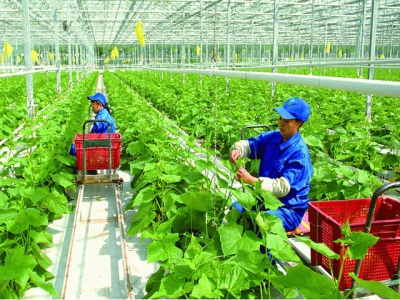Large investors in agriculture

Agricultural enterprises are increasingly growing and taking more interest in investing in agriculture and rural areas, which are becoming the core of the agricultural value chain.
A number of large corporations and enterprises have stepped up their investment in agriculture, especially high-tech agriculture. Photo: Internet
According to the latest information from the Ministry of Agriculture and Rural Development,in 2019, the number of newly established agricultural, forestry and fishery (AFF) enterprises was 2,756, an increase of 25.3 percent compared to 2018, bringing the total number of agricultural enterprises to 12,581, up 36.23 percent.
AFF is one of the areas which has a significantly higher number of enterprises returning to operationthan the number of suspensions.
At the final meeting of the Agriculture and Rural Development sector on December 23, in Hanoi, Minister of Agriculture and Rural Development Nguyen Xuan Cuong said: “In addition to the investment and development of small and medium enterprises, notably, a number of large corporations and enterprises have stepped up their investment in agriculture, especially high-tech agriculture, such as Vinamilk, Nafoods, TH, Dabaco Vietnam, Masan, Lavifood, Ba Huan andBien Dong.”
"The agricultural enterprises areincreasingly growing and taking more interest in investing in agriculture and rural areas, which are becoming the core of the agricultural value chain," said Nguyen Xuan Cuong.
According to the Ministry of Agriculture and Rural Development, together with the impact ofmany investment incentive policies in agriculture and rural areas, agriculturalprocessing, thepreservation industry and supporting industries have gradually been improved. A number of large economic groups have focused on investing in processing agricultural products.
Specifically, in 2019, 17 projects with total investment of over VND 20,000 billion were launched, inaugurated and put into operation. Since2018, total investment capital of over VND 33,000 billion with 30 projects has been operated and are being implemented nationwide, helping improve the quality, designs and diversification of AFF products.
In 2019, the highlight of Ministry of Agriculture and Rural Development’s performance is that the ministry has actively reviewed, revised its strategies, production scales and structures to meet its advantages, market needs and adaptation and climate change; developed a close chain between producers and enterprises in processing and consumption of products.
For example, in the field of rice production, the use of high-quality rice varieties and the restructuring of the rice industry have developed strongly. The proportion of high-quality rice accounted for over 80 percent of exported rice. This has helped raise the average export price of rice from US$502 per ton in 2018 to US$510 perton in 2019.
In addition, advanced and environmentally friendly production processes (such as VietGAP, Global GAP) are widely applied. In 2019, the VietGAP certified area will be 39,300 hectares.
The whole country has developed a chain model with 1,484 chains (an increase of 388 chains compared to 2018), 2,374 products (an increase of 948 products) and 3,267 points of selling certified products in the food safety agricultural chain (an increase of93 points).
Minister Nguyen Xuan Cuong added thatthe Ministry of Agriculture and Rural Development has worked with localities and enterprises to develop chains of some major products such as athree-level chain of high-qualitypangasius in the Mekong Delta region; chain of key forestry products; and chain of 10,000 rice farmers in the Mekong Delta.
In addition to the aforementioned developments, it is noteworthy that in 2019, the market opening and trade promotion of AFF have been focused, promptly addressing problems to promote exports of agricultural, forestry and fishery products to traditional markets and expand to potential markets.
As a result, the number of enterprises allowed to export seafood to the EU, South Korea, China, the Russian Federation and Saudi Arabia has increased.
A total of 13 enterprises have been allowed to export catfish to the United States; agricultural exports has been expanded to some new markets (exporting chicken to Japan; star apple to the United States; mangosteen and milk to China; longan and litchi to Australia).
In 2019, agricultural production faced many difficulties and challenges in productivity, quality, efficiency and competitiveness of the economy was still low. However, the whole industry maintained a good growth momentum and achieved positive results, many targets exceeded the plan. Accordingly, it is estimated that the GDP growth rate of the whole sector reached about 2.2 percent (of which fishery products increased by 6.12 percent and forestry increased by 3.98 percent).
Có thể bạn quan tâm
 Cashew nut exports reach US$3.6 billion in 2019
Cashew nut exports reach US$3.6 billion in 2019 Vietnam continues to be the largest cashew nut exporter in the world with cashew nut exports of US$3.6 billion.
 Agricultural exports target US$42 billion
Agricultural exports target US$42 billion The low target is GDP growth of 2.2 percent, mainly due to the African swine fever which reduces about 1.1 percent of the sector’s growth
 Increasing quality of seafood products for better competitiveness
Increasing quality of seafood products for better competitiveness The prices of material pangasius fish have declined for a long time, causing several farmers in the Mekong Delta provinces to suffer huge losses.